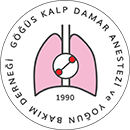

Evaluation of the Effect of Low Cardiac Output Syndrome on Intestinal Flow After Arcus Aorta Surgery in Newborns
Dilek Yavuzcan Öztürk1, Halise Zeynep Genç21Division of Neonatology, Department of Child Diseases and Health, University of Health Sciences, Başakşehir Çam and Sakura City Hospital, İstanbul, Türkiye2Division of Pediatric Cardiology, Department of Child Diseases and Health, University of Health Sciences, Başaksehir Çam and Sakura City Hospital, Istanbul, Türkiye
Objectives: Dynamic changes during arch surgery in newborns may cause ischemia and tissue damage as a result of decreased blood flow in critical organs. In this study, it was aimed to investigate the changes in intestinal blood flow with Doppler ultrasonography (USG) in the presence of low cardiac output in the early period in newborns who had surgical intervention in the aortic arch.
Methods: The study was carried out between August 1, 2021, and August 1, 2022, in newborns younger than 30 days of age at the time of the operation and who had undergone arch reconstruction surgery. The presence of low cardiac output in the cases was determined by low cardiac output syndrome (LCOS) scoring. Initial, 24th and 48th h intestinal flows of the cases with and without LCOS were calculated by Doppler USG. The celiac artery (TC) was used as the measurement site. Peak systolic velocity (PSV), mean systolic velocity (MV), and end-diastolic velocity (EDV) values, resistance index (RI) and pulsatility index (PI) findings of each case were evaluated statistically.
Results: There were 24 cases during the study period. 70% of the cases were male. The median age at the time of surgery was 15 days (IQR 1218 days) and median weight was 3.2 kg (IQR 2.93.4). LCOS was detected in 25% of cases (n=6). Initial median PSV (72 vs. 76 cm/sec), EDV (27 vs. 30 cm/sec), MV (24 vs. 26), RI (0.79 vs. 0.75), and median PI (1.60 vs. 1.75) values of cases with and without LCOS were similar to each other. There was a significant difference between the values of 24th hour median PSV (55 vs. 66 cm/sec), EDV (21 vs. 27 cm/sec), median MV (18 vs.24), median RI (0.84 vs. 0.76), and median PI (1.65 vs. 1.78) of cases with and without LCOS (p<0.05). 48th h median PSV (75 vs. 80 cm/sec), EDV (30 vs. 32 cm/sec), MV (25 vs. 26), median RI (0.80 vs. 0.74), and median PI (1.55 vs. 1.65) values of cases with and without LCOS were similar.
Conclusion: Changes affecting intestinal blood flow were detected in Doppler USG at the 24th h in newborns who developed LCOS after arcus surgery.
Yenidoğanlarda Arkus Aorta Cerrahisi Sonrası Düşük Kalp Debisi Sendromu Varlığının İntestinal Akıma Etkisinin Değerlendirilmesi
Dilek Yavuzcan Öztürk1, Halise Zeynep Genç21Sağlık Bilimleri Üniversitesi, Başakşehir Çam ve Sakura Şehir Hastanesi, Çocuk Hastalıkları ve Sağlığı Anabilim Dalı, Yenidoğan Bilim Dalı, İstanbul, Türkiye2Sağlık Bilimleri Üniversitesi, Başakşehir Çam ve Sakura Şehir Hastanesi, Çocuk Hastalıkları ve Sağlığı Anabilim Dalı, Çocuk Kardiyolojisi Bilim Dalı, İstanbul, Türkiye
Amaç: Bu çalışmada, arkus aortaya cerrahi olarak müdahale edilmiş yenidoğanlarda erken dönemde gelişen düşük debi varlığının doppler ultrasonografi ile intestinal kan akımında olan değişikliklerin araştırılması amaçlandı.
Yöntem: Çalışma, 1 Ağustos 2021-1 Ağustos 2022 tarihleri arasında, operasyon sırasındaki yaşı 30 günden küçük ve arkus rekonstrüksiyo-nu operasyonu yapılmış olan yenidoğanlarda yapıldı. Düşük kalp de-bisi sendromu gelişen ve gelişmeyen olguların initial, 24. ve 48. saat doppler ultrasonografi ile intestinal akımları hesaplandı. Ölçüm yeri olarak çölyak (TC) arter kullanıldı. Her bir olgunun peak sistolik velosite (PSV), mean sistolik velosite (MV) ve end-diyastolik velosite (EDV) değerleri, direnç indeksi (RI) ve pulsatilite indeksi (PI) bulguları istatistiksel olarak değerlendirildi.
Bulgular: Çalışma döneminde 24 olgu mevcuttu. Olguların %70i er-kekti. Ameliyat sırasındaki median yaş 15 gün (IQR 12 gün-18 gün) ve median ağırlık 3,2 kg (IQR 2,9-3,4) idi. Olguların %25inde (n=6) LCOS saptandı. LCOS gelişen ve gelişmeyen olguların başlangıç median PSV (72 vs. 76 cm/sn), EDV (27 vs. 30 cm/sn), MV (24 vs. 26), RI (0,79 vs. 0,75) ve median PI (1,60 vs. 1,75) değerleri birbirine benzerdi. LCOS gelişen ve gelişmeyen olguların 24. saat median PSV (55 vs. 66 cm/sn), EDV (21 vs. 27 cm/sn), median MV (18 vs. 24), median RI (0,84 vs. 0,76) ve median PI (1,65 vs. 1,78) değerleri arasında anlamlı fark vardı (p<0,05). LCOS gelişen ve gelişmeyen olguların 48. saat median PSV (75 vs. 80 cm/sn), EDV (30 vs. 32 cm/sn), MV (25 vs. 26), median RI (0,80 vs. 0,74) ve median PI (1,55 vs. 1,65) değerleri birbirine benzerdi.
Sonuç: Yenidoğanlarda arkus cerrahisi sonrasında düşük debi sendromu gelişenlerde 24. saatte doppler ultrasonografide intestinal kan akımını etkileyen değişiklikler saptanmıştır.
Manuscript Language: English
(417 downloaded)

















